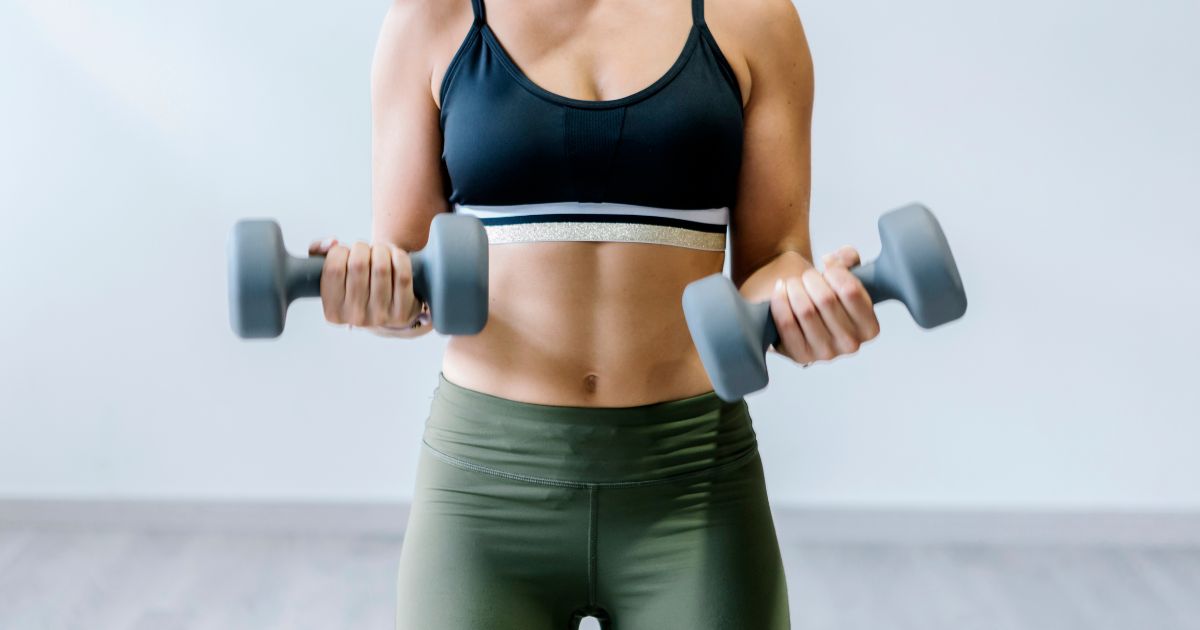
If you’ve been weight training regularly, you might be Googling, "how long does it take to build muscle for females?". While we know that fitness adaptations aren’t instant, it helps to know how long it will take to see results so you don’t feel disheartened at not seeing changes happen over night.
How’s this for positive news: Google searches for weight loss tips are at their lowest since 2004, while more people than ever have been searching for ways to build muscle, according to an analysis from supplement brand Bulk. It's great news that more of us wanting to be stronger than ever, but it's not always easy work. In fact, it often requires a lot of time and dedication.
"Maintaining and building our muscles is vital for our hormonal health and to keep our metabolism fired up," says Monique Eastwood, celebrity trainer and founder of the Eastwood Movement Method and Eastwood Fit app.
Muscle is also important to protect you from osteoporosis as you get older, as well as making day-to-day life way easier in the long run.
While of course bodyweight exercises, like ab exercises and resistance band exercises are great ways to improve your fitness and muscle mass, weighted moves - like dumbbell exercises and kettlebell exercises - are your best best for quick progress, reckon our experts.
For more of their top tips, as well as an exact explainer on how long you should expect to see results after starting a new workout routine, keep scrolling. Don't miss our guide to how much weight should you start lifting and strength training for beginners, while you're here.
How long does it take to build muscle for females? Your guide
We asked some of the best experts in the business for their thoughts, including:
- Nancy Best, founder of Ladies Who Crunch
- Monique Eastwood, celebrity trainer and founder of the Eastwood Movement Method and Eastwood Fit app
- Helen O'Leary, physiotherapist and clinical Pilates instructor at Complete Pilates
How long does it take for women to build muscle?
“In general, it takes around four weeks for an adaptation, eight weeks to see some structural changes and twelve weeks to really notice the difference,” says O'Leary. Best adds: "That doesn't mean your body isn't making adaptations in the early chapter of strength training, under eight weeks though! Your body is laying the foundations to grow muscle fibres."
However, how much muscle you can build depends on so many factors, such as how often you work out, the type of exercise you do and how long you’ve been training. "Building muscle mass isn't a one size fits all approach," says Best.
"Newbie gains" is the name to describe the muscle you can build quickly when you start strength training as a beginner, when your muscles have to learn to quickly adapt to weight training. The more familiar they become with lifting weights, the harder it is for your muscles to grow.
A study from Göteborg University found that beginner lifters can gain around 1.8 to 3.2kg of muscle in their first three months of lifting. Meanwhile, experienced exercisers can expect to grow around 200g of muscle a month if they are training, eating and resting right, according to a paper from McMaster University done in people who had been training for two years or more.
Is it harder for women to build muscle than men?
A 2021 study found that when men and women both performed biceps curls and squat twice a week, for seven weeks, there were no differences in relative muscle mass. But that doesn't mean women will look as big as men after lifting weights due to a few different factors.
Firstly, body fat percentage plays a role. According to the American Journal of Clinical Nutrition, an average healthy body fat percentage is between 21% to 32% for women and 8% to 19% for men. “As you can see, there's quite a lot of difference," says O'Leary. "As women we are designed to hold more essential body fat for insulation, to protect our internal organs, vitamin storage and hormone regulation needed for healthy pregnancies." That means muscle often doesn't look as rippling as it might on, say, a man because it's covered by more fat.
The size of the muscles themselves may also be smaller. "It is generally harder for woman to build muscle than men as we don’t have as much testosterone. As we age as women, this hormone also depletes," says Eastwood.

How can you build muscle faster?
Looking for ways to supercharge your muscle building abilities? Spoiler alert: it involves so much more than just your workouts.
You might already know, but there are three main aspects of fitness:
- Training
- Nutrition
- Recovery
Working on all of these areas is the best way to build muscle.
1. Training
"I always suggest to my clients that being consistent is the best way to train, with a strong focus on your technique," says Eastwood. Given it takes around twelve weeks to notice your new muscle, sticking with a routine is really important.
O'Leary says you need to be strength training two to three times a week — and the research supports that, too. The PLOS One paper from this year showed that two to three resistance training sessions a week helped increase upper-body strength by 5.2% a week in young females.
Try this: Best recommends doing full body workouts a few times a week for good results. "However, if you're keen to focus on growing a particular muscle group, aim to target it twice a week with adequate rest days in between, so your body can perform at its best when you pick up your weights," she says.
O'Leary also advises focusing on the eccentric — or lowering — phase of your exercise. "For example in a squat go slower down than you go up," she says. Research suggests that this leads to the greatest muscle gains.
Our guides to how much weight to start lifting might come in handy here, as will our guide to the best weight lifting exercises.

2. Nutrition
"To support your training, make sure you are consuming enough protein, lean animal or plant protein. Balance your diet with complex carbs and plenty of greens," adds Eastwood.
While many people like to cut calories when they start exercising, the body actually needs an excess of calories to build muscle, says O'Leary.
Try this: "The best way to build muscle is to focus on the fuel your body needs," she stresses (energy boosting foods, we're looking at you). "Ensure you are not in a calorie deficit so that your body can put down new muscle," she says.
In particular, getting enough protein is crucial for repairing and building muscles. Not sure what protein actually is? Read our expert-led and explainers on vegan protein sources, plus don't miss a more detailed breakdown of what to eat after a workout or how long after eating you can exercise, here.

3. Recovery
If you over train or don't recover from your exercise, your body won't be able to repair and rebuild your muscles. In turn, you won't see progress as quickly as you'd hoped. Yep - workout recovery really is key to fitness gains.
Try this: "Make sure you are getting sleep for recovery and reduce the levels of cortisol in your body which can inhibit muscle growth," says O'Leary.
Why aren't I building muscle?
Building muscle can be hard. While online it may look like everyone is perfectly sculpted, most of these people will have been training for years and years, so don't expect to have muscles like them in a few short weeks of exercise. It also requires you to really push yourself: if you've been lifting the same weight for weeks and weeks, you're doing it wrong.
Work with the principle of progressive overload, which means continuously adding more load to the muscles. As soon as a weight starts to feel easy to lift for your desired reps, you need to lift heavier. It can be as small as an extra 1.25kg, but every little helps.
It's also important to note that visible muscles aren't an indicator of overall health. Actually, women who have abs may be below the healthy body fat percentage for a women. Tick off your training, eat well, recover adequately, and the rest will follow.






